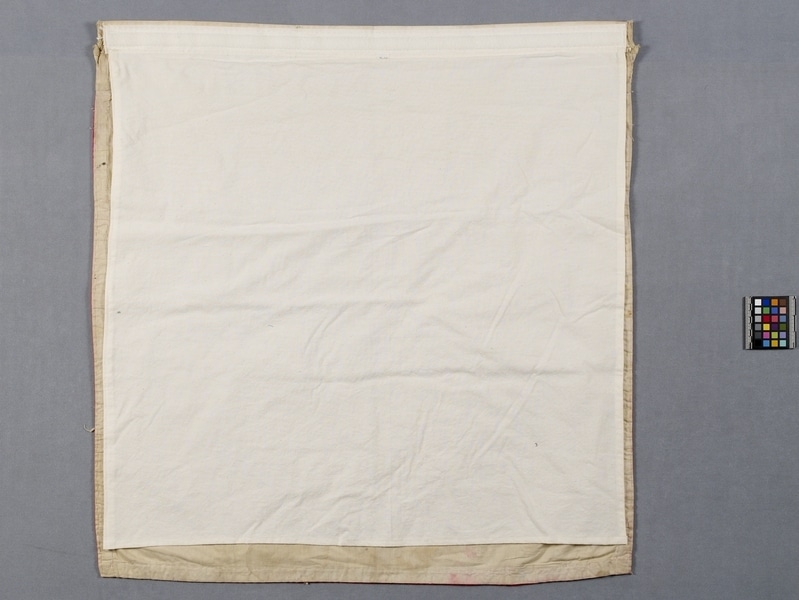Cantonese Opera Tablecloth Item Number: N1.740 from the MOA: University of British Columbia


Description
Ecru tablecloth with embroidered designs. On the front are fu dog and cherry blossom motifs in silver, blue, pink and mauve. There are glass eyes, white fur and tin reflectors. Three edges are lined with silver braid on deep pink ground. The top edge and back is lined with natural-coloured cotton.
History Of Use
This panel was used as a table cover. It was fastened to the top and front of a table to decorate it and conceal the structure. Its lavish decoration suggests that it was used to demonstrate the fact that the household was wealthy. Cantonese opera stages at that time were nearly bare, with no scenery and only a minimum of props and furniture, such as a table and two chairs. Settings were indicated by these objects, by the actors’ mime to indicate doors, walls, etc., and sometimes by signs that were hung up to indicate the location.
Costumes, props, and stage fittings from the period before World War II can be dated in part by their ornamentation. Those decorated with silver-coated brass disks are likely to be the oldest, followed by those decorated with mirrors. Sequins came into use in the 1930s, although they had been used sparingly before, and heavily-sequined costumes came into use in the late 1930s, continuing into the 1950s.
The conditions of production of costumes pre World War II are not known with certainty. As most costumes have repeated motifs, some method must have been used to replicate them for embroidery and couching. This work was probably done on a putting-out basis under the auspices of the production company, by women. The final finishing may have been done by men in the company headquarters.
Iconographic Meaning
The lavish decoration symbolizes the wealth of the household or palace.
Cultural Context
theatre
Narrative
A large group of Cantonese opera costumes, musical instruments, props, trunks, and stage fittings was left with the Jin Wah Sing Musical Association, apparently by some of the many itinerant troupes visiting Vancouver to perform in the Chinatown theatres in the pre World War II period. There is no certain knowledge of why these materials were not taken back to China by them. They were used by the Jin Wah Sing Musical Association in their performances until they became too dated. The association continued to preserve them carefully, storing them in their headquarters and in the basement of the Chinese Freemasons building until several groups of materials were sold and donated to the Museum of Anthropology.
Specific Techniques
Wear on similar costume elements shows that the fabric was woven with a silk weft and cotton warp, or vice versa. Embroidery is done in satin stitch with spun thread, not floss. Some spun thread is couched on the surface. All visible stitches are done by hand.
Item History
- Made in Guangzhou, Guangdong, China ? during 1920
- Collected in Vancouver, British Columbia, Canada
- Owned by Jin Wah Sing Musical Association before August 28, 1973
- Received from Barrett Montford Endowment Fund (Funding source), Jin Wah Sing Musical Association (Seller), Leon & Thea Koerner Foundation (Funding source), Museum of Anthropology Donations Fund (Funding source), Mah Society of North America (Funding source), Canada-China Friendship Association (Funding source), Quon H. Wong Agencies (Funding source) and Edith Low-Beer (Funding source) on August 28, 1973
What
- Name
- Cantonese Opera Tablecloth
- Identification Number
- N1.740
- Type of Item
- tablecloth
- Material
- silk fibre, cotton fibre, rabbit skin, brass metal, silver metal and dye
- Manufacturing Technique
- spun, woven, cut, embroidered, couched and sewn
- Overall
- height 86.0 cm, width 84.5 cm
Who
- Culture
- Chinese: Cantonese
- Previous Owner
- Jin Wah Sing Musical Association
- Received from
- Barrett Montford Endowment Fund (Funding source), Jin Wah Sing Musical Association (Seller), Leon & Thea Koerner Foundation (Funding source), Museum of Anthropology Donations Fund (Funding source), Mah Society of North America (Funding source), Canada-China Friendship Association (Funding source), Quon H. Wong Agencies (Funding source) and Edith Low-Beer (Funding source)
Where
- Holding Institution
- MOA: University of British Columbia
- Made in
- Guangzhou, Guangdong, China ?
- Collected in
- Vancouver, British Columbia, Canada
When
- Creation Date
- during 1920
- Ownership Date
- before August 28, 1973
- Acquisition Date
- on August 28, 1973
Other
- Item Classes
- textiles
- Condition
- good
- Accession Number
- 0248/0125